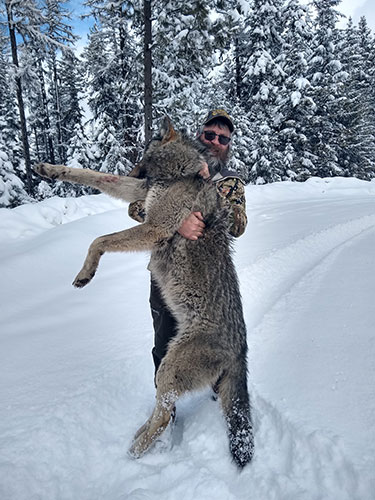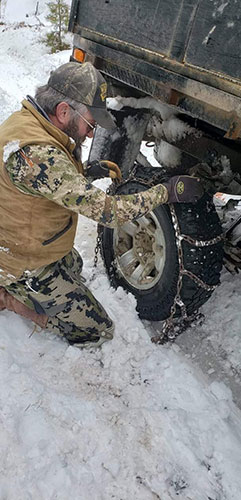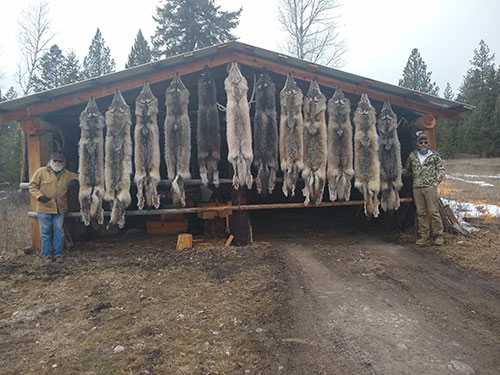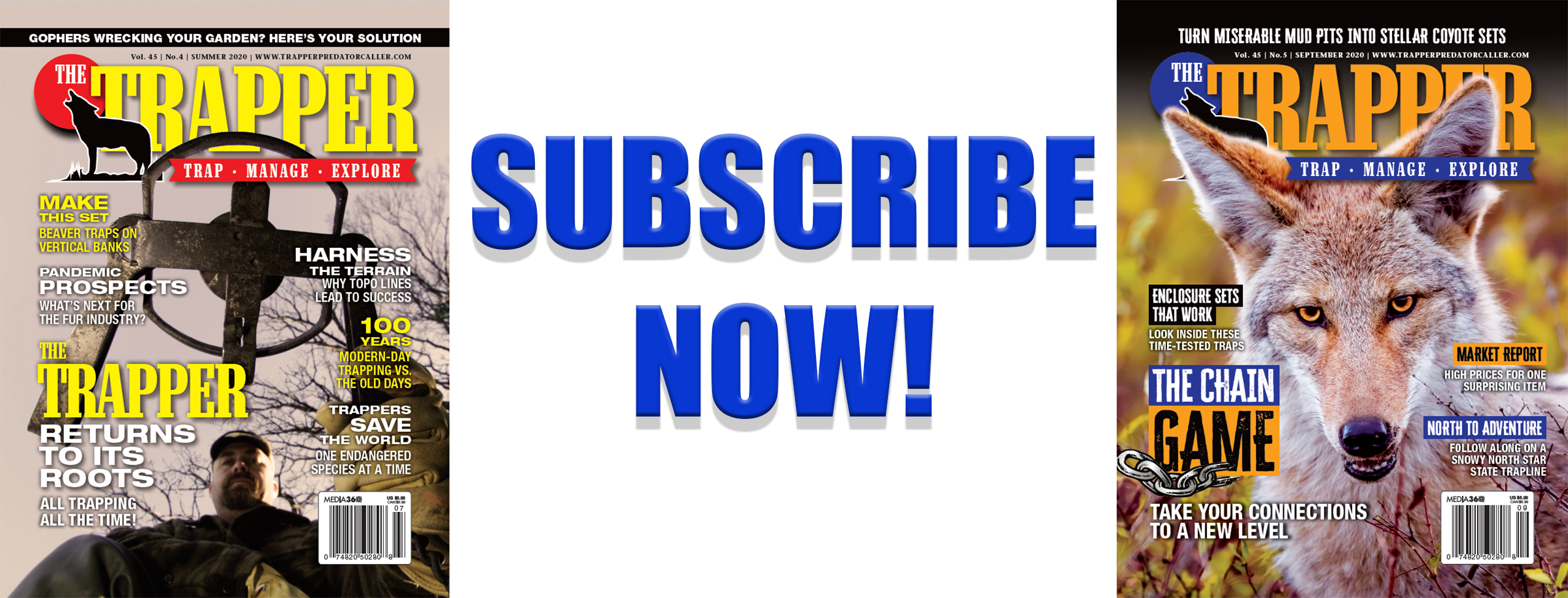In the rugged mountains of western Montana, the author has found the secret to wolf trapping success. Follow along on his adventures.
By Dan Helterline
I began my trapping career like many young trappers, pursuing muskrats and water-dwelling furbearers on my grandparents’ pond as a young schoolboy. That eventually morphed into trying to trap larger furbearers and canines as I got older and started high school. Being of school age in rural western Montana in the ‘80s, there was no shortage of critters to pursue in the surrounding waterways and mountains.
It wasn’t far downstream on the Clark Fork River near present-day Thompson Falls where David Thompson established the Saleesh House. In 1809, racing to beat the Hudson Bay Company and American fur trading interests, he established this outpost for the North West Company to try to gain control of the region’s fur interests.

A typical 95-pound male gray wolf taken on the author’s winter trapline. Photo credit Dan Helterline.
David Thompson was an accomplished fur trader, surveyor and cartographer, traveling more than 90,000 kilometers and mapping 4.9 million acres of North America along the way. He was affectionately known as Koo-Koo-Sint by the local natives, which translates to “stargazer,” and was probably given the name due to his reliance on a sextant to do most of his mapping. David Thompson was the first European fur trader to enter Northwest Montana and many local landmarks bear the name of Koo-Koo-Sint to this day.
After high school, I tried my hand at college for a couple years and in the summer months was employed by the U.S. Forest Service as a firefighter. One of my summer supervisors from the Forest Service thought that I should give smokejumping a try, he was confident I would succeed at smokejumping and it would be a good fit for me. For those not familiar with smokejumping, it’s a branch of the Forest Service and Bureau of Land Management that trains experienced firefighters to parachute into remote locations to initial attack emerging wildfires, in an attempt to control them while they are small. Dave was correct in assuming this would be a good fit for me, it gave me the winters off to pursue furbearers with hounds and trapping. I soon decided this was to be my chosen career path and said adios to college.
It was during college that I acquired a few hounds and started pursuing bobcats and lions during the winter months, in addition to sporadic trapping. Hound hunting became a passion that would lead me all over Montana and into Idaho in pursuit of North America’s largest felines. In the late ‘90s I started guiding lion hunters in the remote and rugged Selway Bitterroot Wilderness of central Idaho for multiple winters. We would hunt out of very remote tent camps accessible only by snowmobiles and airplanes equipped with skis to land on remote, snow-covered backcountry airstrips. It was lion hunting in its purest form, remote country that was hunted on foot without the use of modern GPS units or fancy four-wheel drives. I would almost never see another person on those hunting trips unless they were with my hunting party, it truly was the best of times!
It was during that time period that the government wasn’t satisfied with the rate at which wolves were reoccupying their historical territory, so a reintroduction plan was hatched.

The author chaining up his Toyota Tacoma, another daily ritual on a winter wolf trapline. Photo credit Dan Helterline.
There have always been a few wolves trickling down from Canada through Glacier National Park and into the Thompson River country where I’ve spent my entire life hunting and trapping, but apparently that reoccupancy rate wasn’t sufficient enough, so a deal was made with our neighbors to the north to bring us some of their abundant wolves, and release them into Montana and Idaho. In 1995, wolves from Canada were released in Yellowstone Park and the following year into central Idaho. This apex predator now had an abundant food supply with virtually no competition, so its numbers expanded and dispersed at an unprecedented rate. It wasn’t long before they showed up in the Selway country and started having a devastating impact on game numbers there.

A typical season’s catch of wolves displayed on the woodshed at the old Bobby Jones Ranch, currently owned by 82-year-old Jim Shallenberger, pictured on the left. Photo credit Dan Helterline.
It was during the same timeframe that wolf numbers exploded in western Montana and northern Idaho, with similar effects on ungulate populations. Wolf population numbers reached the established recovery levels by 2002 and citizens were promised that they would be removed from the Endangered Species List and management handed over to state agencies at that point. As most of us know, this turned into a long, emotionally drawn out battle where science and biological data were ignored. After a false start in 2009, a permanent hunting and trapping season was finally established in Montana in 2011. While the battle was raging in the courtrooms, wolves remained protected and their populations expanded and dispersed exponentially, wreaking further havoc on game populations.
In 2011, the sun was starting to set on my career as a Forest Service smokejumper and I started shifting gears to trapping full time. Wolf trapping was a fledgling endeavor in Montana and I would soon find out that information from other successful trappers was almost nonexistent. There was some information about trapping wolves in Alaska, but trapping conditions that far north varied so much from the conditions we encounter locally that only a small percentage of the Alaska information was relatable. It appeared it was going to be the school of hard knocks, plus take some trial and error to master the art of wolf trapping. If I could become efficient at trapping wolves early on, I was hopeful that I could provide instruction for other wolf trappers down the road.

A client from Dallas, Texas, with a nice male black wolf taken on a wolf trapline adventure trip guided by the author with Cody Carr’s Hunting Adventures. Photo credit Dan Helterline.
My first season of wolf trapping met with minimal success, I had wolves close to my sets but no catches were made. I desperately wanted to master this new endeavor, so one evening while poring over an Ogorman’s catalog, I came across his advertisement for personal longline trapping instruction, the title of the ad read, “I WANT TO HELP MAKE YOU THE VERY BEST TRAPPER YOU CAN POSSIBLY BE.” It didn’t take long for me to realize this might be the exact boost needed to jumpstart my wolf trapping career. If you’re not familiar with Craig and Dana Ogorman, Craig is undisputedly the country’s leading predator trapper, and they together run a top-notch lure-making business.
That following May I packed up and headed down to Broadus to spend some quality time with Craig on his ADC line. The time spent with Craig was priceless to say the least, the next fall’s catch skyrocketed to well more than 100 coyotes and I caught my first two wolves! I was hopeful that my wolf trapping career was underway. I started using the principles of success on my coyote line and also applied them to wolf trapping. I began streamlining things and going with the “keep it simple’’ mentality. Soon I had my sets whittled down to the time-tested dirt-hole set and flat or pee-post sets. I tried many other more elaborate sets, but failed to have success with any of them.
One of the main hurdles encountered with wolf trapping was keeping sets functional during the season that lasts from mid-December through February. Western Montana’s winters are mild in comparison to Alaska’s, but temperatures fluctuate greatly throughout the winter and we experience many freeze-thaw cycles that make it tough to keep traps working. My best solution to the problem is using quality waxed dirt, and later I would transition to waxed sand. I would also locate set locations that were weather resistant and that didn’t receive the brunt of the snowfall during numerous winter storms. When one of these locations intersected with wolf sign I would call that a “money spot!”

Father and son clients posing with a lifelong dream of harvesting a black wolf. Taken on a wolf trapline adventure trip guided by the author. Photo credit Dan Helterline.
My 20-plus years of cat hunting definitely played an early role in my initial success, as spending all winter in the woods chasing lions and bobcats gave me a solid picture of wolf movements and pack densities. As the wolves rapidly increased in numbers they started having a dramatic impact on cat behavior and hound hunter success. The wolf packs started hazing lions off of their kills and claiming the lion kills as their own.
This had a twofold effect on lion behavior, as lions soon became more aggressive toward hounds and tougher to tree from the constant wolf harassment, and the instances of lions killing hounds went up dramatically. In order to survive, lions were often forced to kill again immediately after losing a kill to wolves. This was just another negative impact on big-game herds in the area, as the exponential added predation drove big-game populations to nearly be nonexistent, the few ungulates remained sought refuge on private agricultural land in the valleys. Elk and moose took the biggest hit, and this is blatantly evident by the many closed game units and reduced tags for both species.
Big-game hunting in my local area became nothing short of a waste of time due to the lack of game. It drove me even harder to become proficient at wolf trapping. Sadly, gone are the days of elk camp in the mountains with friends and family, drainages that once echoed with the bugling of elk in the fall were now eerily silent and fresh snows revealed nothing but wolf tracks.
My time spent lion hunting rapidly declined as I became obsessed with the pursuit of wolves. My hounds soon took a back seat and when my last two old dogs died, I closed that chapter in my life to pursue wolves full time. I have a lot of great memories from my years pursuing cats with hounds, but it was now time to turn the page and wolves would be my main focus.

The author baiting a dirt-hole set, one of the most productive sets deployed on his winter wolf trapline. Photo credit Dan Helterline.
My success rapidly grew in a few short seasons. My daughter joined me and soon we were catching our quota of wolves every winter. When I began trapping wolves, the selection of traps on the market was very limited. I initially purchased some MB 750s, but soon became unhappy with their performance. I also tried Bridger #5s for a while but was not satisfied with them, either.
I came across a TS85 in a trapping catalog and upon initial examination it looked like it had promise. It was designed for beaver trapping by Tim Sawatzky, but I was confident that I could modify it into a worthy wolf trap. I purchased a few and began my journey down the road of what is now my bread-and-butter wolf trap. In the beginning, I hit a few small roadblocks during the modification process. I contacted Tim and he was extremely helpful to work through minor issues developing these modifications. Tim has a lifetime of trap manufacturing under his belt, as well as being an extremely accomplished trapper, and I can’t begin to thank him enough for his insight and support.
Two seasons ago a local hunting outfitter approached me with the proposition of guiding clients on wolf trapline adventure trips. The same trip was widely marketed in Canada and Alaska and Cody felt that with the size of my trapline, along with my high success rate, that he would be able to market similar trips in Montana. I thought about it for some time. I really enjoyed the freedom and independence that my wolf trapline brought me, not to mention the gratitude I felt for actually making a difference in predator control and giving big-game herds some much-needed relief. I finally agreed to try it for a season — but only if I didn’t have to change or modify anything that I was currently doing.
The first season went surprisingly well and I was about 60% successful showing clients around on my trapline and harvesting some wolves in the process. Last year was my second season guiding clients on my line and I was very successful. We harvested wolves on five trips in a row.

A season’s catch of canines — coyotes, red foxes and wolves. The author’s Great Uncle built this barn. Joseph Helterline arrived in Wild Horse Plains in the 1870s to homestead in the valley. The barn was built around the turn of the century and still stands tall to this day on Helterline Lane. Photo credit Dan Helterline.
One hunter was able to get a gray and a black wolf in the same week, plus a coyote and a fox, the canine trifecta! He left a very happy camper to say the least. I had another pair of guys that had been on two Canadian trips hunting wolves from blinds over bait, and in the combined time of almost 300 hours spent in the blinds, they never even saw a wolf. On the third day of our hunt we caught a double at one location, and both were able to harvest a wolf the same day, one was a 112-pound giant.
I’ve started to really cherish the excitement and overwhelming emotion that these trappers and hunters experience when they encounter a wolf at close quarters for the first time. They often say it’s the trip of a lifetime and never even realized what an awesome experience it could be.
Montana’s wolf trapping has now survived its first decade, and there is a much wider selection of wolf traps currently on the market. I’ve looked at all of them and have field-tested most, but I still keep coming back to my TS85s based on performance and affordability. I’ve started to sell a few of them by word of mouth and now they are the favorite trap of friends and fellow wolf trappers in Idaho and Alaska, as well as Montana.
Recently, there has been a shift in government at the state level and there was a flux of beneficial laws passed and signed by our newly elected governor that will help bring wolf numbers closer to acceptable management levels. When I started down this road I never quite envisioned that it could blossom into such a full-time, fulfilling endeavor. I have been able to provide private wolf trapping field instruction to individuals, in addition to hosting instructional wolf trapping seminars in the off-season. I’ve had the opportunity to work closely with the Montana Fish, Wildlife & Parks to develop new wolf trapping regulations and have helped instruct the field portion of the mandatory wolf trapping certification course. These are both efforts that I’m very honored to be part of. Looking back, it’s been a fantastic and rewarding journey.
If you would like more information about the guided trapline adventure trips mentioned in this article, visit HuntWithCody.com. If you’re interested in individual in-the-field wolf trapping instruction or attending one of my seminars, I can be reached at thepinepup@gmail.com. I also have a very limited number of custom modified wolf traps for sale.


